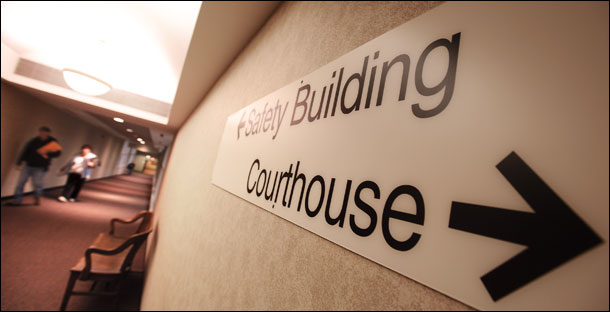DA, legislator seek felony protections for court threats
By: Jack Zemlicka, [email protected]//December 20, 2011//
DA, legislator seek felony protections for court threats
By: Jack Zemlicka, [email protected]//December 20, 2011//

When Watertown resident Mark Seeber in 2009 threatened to shoot employees at the Jefferson County Courthouse and blow up the building, prosecutor Sue Happ sought severe punishment.
But state statutes limited the Jefferson district attorney, who convicted Seeber of two Class A Misdemeanors as a result of the incident; offenses that carried a maximum each of nine months in jail and a $10,000 fine.
While threats or intentional bodily harm to judges register a felony offense, the same punishments are not in place for individuals who verbally or physically attack other court staff.
Happ and Wisconsin State Rep. Andy Jorgensen, D-Fort Atkinson, are now working to change that. They’re seeking an expansion of the law to include felony protections for clerks of court, their staff members, employees of the Supreme Court, prosecutors and public defenders.
“We work in a very volatile environment,” Happ said. “We need to at least have public awareness that if you threaten to shoot people, there should be an equivalent response to what other types of public employees have in place.”
Jorgensen said he was shocked statutes provide felony protections to other state employees such as those in the Department of Revenue and Department of Workforce Development, but not to court employees.
Assembly Bill 424, introduced Wednesday, would make individuals that intentionally cause or threaten to cause bodily harm to court employees, prosecutors or public defenders acting in the scope of their duty subject to a Class I Felony.
While the $10,000 fine tied to the charge is the same as a Class A Misdemeanor, the felony allows for imprisonment of up to three-and-a-half years, compared to a nine-month jail sentence for the misdemeanor.
“Court employees should have that added protection if they are harmed or threatened at work,” Jorgensen said, “and the individual responsible should be charged with a felony.”
A broader law also would give Happ and other prosecutors freedom to bring more severe penalties against egregious offenders, such as Seeber.
In the 2009 incident, Seeber never had a weapon and didn’t physically injure anyone, Happ said, which ultimately led her to charge the case as a disorderly conduct and threat of a dangerous weapon because it was the only category the case fit.
According to the criminal complaint for the 2009 incident, Seeber, who was intoxicated at the time, threatened to get a gun and shoot everyone at the courthouse and also use dynamite to blow-up the building.
“I thought the penalties available were woefully inadequate to deal with that case,” Happ said. “It would be nice to give us the ability, in egregious cases, to insist on felony conviction.”
Jefferson County Circuit Court Judge William Hue said courthouse staff members deserve increased protection for intentional offenders, but he doesn’t want impaired members of the public unfairly targeted for crimes.
“When we try to deal with mental health issues by making a crime out of it, that can complicate things,” he said. “The person might not have really had criminal intent rather it was a manifestation of mental illness.”
Seeber had a history of mental illness and prior offenses, Happ said, which contributed to her decision as to how to charge the case.
The goal of the bill, Jorgensen said, is not to promote an increase in arrests or to put more people in prison. It is meant to give prosecutors more flexibility when faced with a courthouse threat, he said, and provide more of deterrent for would-be offenders.
“I don’t think this will be abused,” Jorgensen said. “If anything, if it is viewed as an overreach, it will come out in a court of law.”
Legal News
- Some State Bar diversity participants walk away from program
- Wisconsin court issues arrest warrant ‘in error’ for Minocqua Brewing owner
- Iranian nationals charged cyber campaign targeting U.S. Companies
- Facing mostly white juries, are Milwaukee County defendants of color truly judged by their peers?
- Milwaukee Mayor speaks in D.C. Tuesday at White House water summit
- Chicago man sentenced to prison after being caught with ‘Trump Gun’
- FTC bans non-competes
- Gov. Evers seeks applicants for Dane County Circuit Court
- Milwaukee man charged in dismemberment death pleads not guilty
- Democratic-led states lead ban on the book ban
- UW Madison Professor: America’s child care crisis is holding back moms without college degrees
- History made in Trump New York trial opening statements
WLJ People
- Power 30 Personal Injury Attorneys – Russell Nicolet
- Power 30 Personal Injury Attorneys – Benjamin Nicolet
- Power 30 Personal Injury Attorneys – Dustin T. Woehl
- Power 30 Personal Injury Attorneys – Katherine Metzger
- Power 30 Personal Injury Attorneys – Joseph Ryan
- Power 30 Personal Injury Attorneys – James M. Ryan
- Power 30 Personal Injury Attorneys – Dana Wachs
- Power 30 Personal Injury Attorneys – Mark L. Thomsen
- Power 30 Personal Injury Attorneys – Matthew Lein
- Power 30 Personal Injury Attorneys – Jeffrey A. Pitman
- Power 30 Personal Injury Attorneys – William Pemberton
- Power 30 Personal Injury Attorneys – Howard S. Sicula











